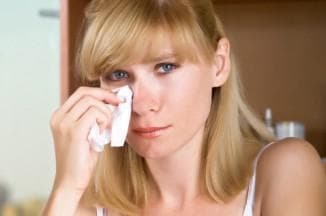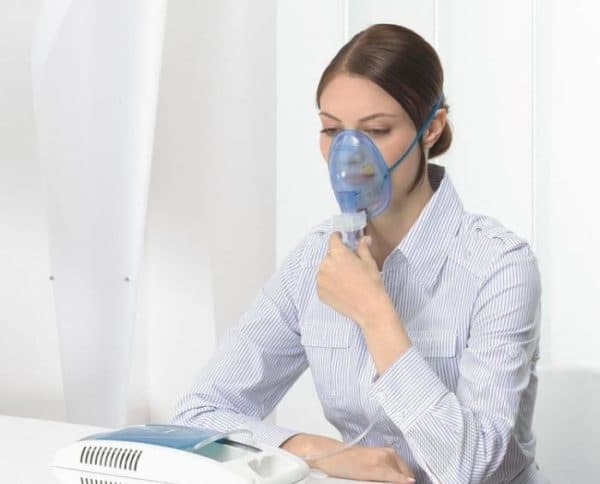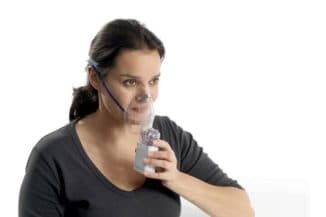
Sinusitis - an inflammatory process, localized on the mucosa of the maxillary sinuses. It can be one-sided and bilateral, proceed in acute and chronic form. This pathology can develop in patients at any age, the causes of the inflammatory process in the maxillary sinus can be any other diseases of closely located ENT organs and infections.
Contents
- 1 Kinds of sinusitis
- 2 Inhalation with nebulizer
- 2.1 Rules for inhalation with nebulizer
- 3 Classical inhalations
- 4 Possible complications
- 5 Video
Types of sinusitis
 There are several types of diseases, the classification of which depends on the location of inflammation, the causes of sinusitis, morphological signs.
There are several types of diseases, the classification of which depends on the location of inflammation, the causes of sinusitis, morphological signs.
By location:
- single-sided - inflammatory process is diagnosed only from one side;
- bilateral - pathology affects two maxillary sinuses simultaneously.
Because of the onset:
- viral - sinusitis develops due to ingestion of viruses into the body;
- bacterial - this means getting into the body of pathogenic / pathogenic microorganisms;
- fungal - an inflammatory process provoked by growth and reproduction of fungal colonies;
- allergic - sinusitis of this kind occurs only when allergens are inhaled by the nose;
- traumatic - inflammation begins either when an injury is caused, or when a foreign body enters the maxillary sinus.

Inhalations will significantly ease the condition of the patient with sinusitis
. In the form of flow:
- acute - occurs suddenly, it is quite severe, characterized by high temperature;
- chronic - is necessarily a consequence of untreated acute sinusitis.
In addition, medicine distinguishes catarrhal, purulent, polyposic sinusitis.
Any of the listed types of the inflammatory process should be treated with antibacterial drugs( effective antibiotics for sinusitis), doctors also prescribe general restorative therapy, immunomodulators. But the most effective method of quickly getting rid of signs of sinusitis is inhalation. They can be carried out with the help of special equipment( nebulizers), and according to the experience of our ancestors( a teapot or any dishes with a blanket).
Before starting inhalation, you need to know which solutions will safely and effectively affect the maxillary sinuses.
Inhalation by nebulizer

For inhalations, a nebulizer requires a drug specifically designed for inhalation procedures.
The nebulizer allows drip micromotion of the maxillary sinuses - the drug will have a direct effect on the pathologically altered mucosa. How to conduct inhalation with a nebulizer?
 First, you need to purchase a drug specifically designed for inhalation procedures - a specific name will be indicated by the doctor in charge. Such funds for nebulizers are sold in special bottles in a dosage of 5 ml.
First, you need to purchase a drug specifically designed for inhalation procedures - a specific name will be indicated by the doctor in charge. Such funds for nebulizers are sold in special bottles in a dosage of 5 ml.
Secondly, 2-3 ml of brine or plain water should be poured into the special compartment of the equipment, but in no case distilled! If the distilled water is used in the inhaler, the patient may experience a spontaneous attack of suffocation.
Thirdly, directly the drug is added in small amounts - no more than 2 ml for one procedure of inhalation.
 From this article, you can find out what is better to treat a cold for a child 2 years.
From this article, you can find out what is better to treat a cold for a child 2 years.
What effective treatment of a cold in children 3 years old is most often chosen, is indicated here in the article.
How does an inhaler for a cough and runny nose omron, is listed here: http: //prolor.ru/g/lechenie/ ingalyator-omron-dlya-detej.html
Note: it is possible to treat sinusitis even by inhalation with the use of fiz.solution - the mucous membrane will be moistened, purulent clusters - liquefied and removed from the sinuses. Perhaps, specifically, the therapeutic effect of such inhalations and not have, but that greatly accelerate the process of recovery - the truth.
Rules for inhalation with nebulizer
In order for this procedure to be really effective, it is necessary to carefully follow the recommendations:
- Inhalations can be performed only 2 hours after active activity, not earlier.
- Breathing should be deep and calm.
- Immediately after inhalation, you must remain at rest for at least an hour.
- The number of inhalations per day is from 3 to 5.
It is advisable to perform inhalations at night - this will ensure a calm / deep / healthy sleep to the patient.
Classic inhalation
 If the nebulizer drips the drug, steam inhalations are more extensive - steam with medicinal decoctions or solutions literally envelops the oral cavity, the maxillary sinuses, and the nasal passages. Classic inhalations for sinusitis can be much more effective than using a nebulizer, but only if they are carried out at the initial stage of development of acute inflammation or recurrence of chronic.
If the nebulizer drips the drug, steam inhalations are more extensive - steam with medicinal decoctions or solutions literally envelops the oral cavity, the maxillary sinuses, and the nasal passages. Classic inhalations for sinusitis can be much more effective than using a nebulizer, but only if they are carried out at the initial stage of development of acute inflammation or recurrence of chronic.
Recipes of solutions for classical steam inhalations:
- Chamomile pharmacy / sage / thyme. These medicinal herbs can be used as an independent agent and as a dry "cocktail".Decoction is easy enough: take 2 tablespoons of "mix" or an individual plant and pour two glasses of water, heat on a water bath to a boil, then cook for 3 minutes. From this article it becomes clear whether it is possible to wash the nose with chamomile to the child or not.
- Propolis. You can use propolis tincture for inhalations - it is sold in pharmacies. Take 30 ml of tincture, dilute in 300 ml of water.
- Horseradish and garlic. These two vegetables have powerful antimicrobial properties and therefore inhalations with their use will have the optimum effect - they will purify the maxillary sinuses from accumulated pus and mucus. It is necessary to grate the root of horseradish and garlic on a small grater, take 1 teaspoon of the mass and add half a liter of hot water to them.
- Essential oils. The usual addition of a few drops in the hot water of eucalyptus essential oil, tea tree, cloves will also have the expected effect. How to use the essential oil of thuja for adenoids is indicated in the article.

Horseradish has powerful antimicrobial properties and therefore inhalation will have the best effect - they will purify the maxillary sinuses from accumulated pus and mucus.
Features of classical inhalations:
- , this procedure can not be performed at high body temperature;
- if the patient has hypersensitivity or an individual intolerance to any listed component, then inhalation with it is contraindicated;
- for steam procedures you need to breathe in deeply the medical pairs with your nose, but breathing should be calm at the same time;
- if sinusitis is accompanied by catarrhal symptoms or sore throat, alternately inhale the nose with the nose / mouth.
Inhalations with steam can be carried out 2-3 times a day, after them you just need to wrap yourself in a blanket / plaid, but never go out or balcony, do not stay in a cool room
Possible complications
Treatment of inflammation of the maxillary sinusesshould be carried out in full and within the prescribed dosage and duration. Otherwise, complications develop - for example, meningitis, frontalitis, otitis media, sepsis.
Acute antritis in the absence of competent treatment always turns into a chronic form.
Video
In this video - all methods and rules of inhalation:
Genyantritis can be treated with inhalations, and, within the framework of home conditions. But you need to consult with your doctor, get permission from him to conduct the procedure and clearly adhere to the instructions issued to him. As a rule, inhalations in the considered inflammatory process can shorten the duration of treatment by almost two times. And do not forget about the prevention of sinusitis.
